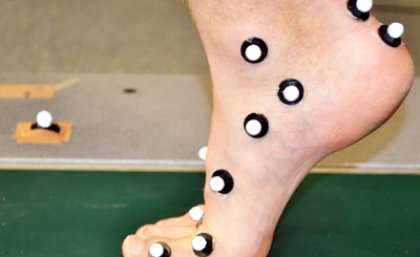
New insights into how foot muscles support the arch of the foot could spark a change in the design of running shoes, following a study led by The University of Queensland.
The study’s findings are also expected to impact the treatment of foot conditions, the design of efficient prosthetic and robot limbs and improve understanding of how humans came to walk and run efficiently on two feet.
Dr Glen Lichtwark at UQ’s School of Human Movement Studies said the importance of muscles in moving a person’s legs was already well-known, but muscles in the foot had been deemed less important.
“Ligaments in the foot have generally been regarded as the main support for the foot arch, which helps us walk and run by acting as a spring,” Dr Lichtwark said.
"As you compress the arch it stretches the bottom of the arch and that causes some tension in the ligaments that store elastic energy, which can be released when you push off.
“Anatomical research suggests that muscles in the feet may also be important in supporting the arch of the foot as well and we were really interested in whether or not these muscles have any capacity to assist this function of the foot, ” he said.
Two experiments were conducted to investigate the role of muscles in the foot. The first experiment required seated participants to have a weight applied to their knee while the researchers studied activation of foot muscles, using needle electrodes.
"We found that after a certain amount of force was applied, these muscles started to activate and the more weight we applied, the more these muscles turned on,” Dr Lichtwark said.
In a second experiment researchers electrically stimulated the foot muscles under different loads.
“We found that as the muscles were stimulated, they caused the arch of the foot to rise, actively supporting the arch,” Dr Lichtwark said.
“The muscles were basically acting as a parallel support to the ligaments effectively stiffening the foot.”
The researchers believe the findings may have implications for the design of running shoes.
"Running shoes should be designed to complement the function of the muscles rather than work against them,” Dr Lichtwark said.
"Because we think these muscles respond to how much load you put on them, if you put in some kind of cushioning effect on one side of the foot for instance, then that might slow the response of these muscles in being able to adjust to different surfaces or uneven terrain.”
The findings may also have implications for rehabilitation of muscular skeletal injuries and may lead to the design of exercise programs to strengthen foot muscles where there are problems with the arch.
The research was carried out as part of PhD research by Luke Kelly from The University of Queensland under the supervision of Dr Glen Lichtwark and Professor Andrew Cresswell who works as a sports podiatrist, in collaboration with Aspetar Orthopeadic and Sports Medicine Hospital, Doha, Qatar.
The findings were published recently in the Journal of the Royal Society Interface.
Media: Caroline Day, Marketing and Communications, UQ School of Human Movement Studies, +61 7 3365 6764 or caroline.day@uq.edu.au or Kirsten O'Leary, Senior Media and Communications Officer, Faculty of Health and Behavioural Sciences, +61 7 3366 3035 or k.oleary@uq.edu.au
.jpg)









